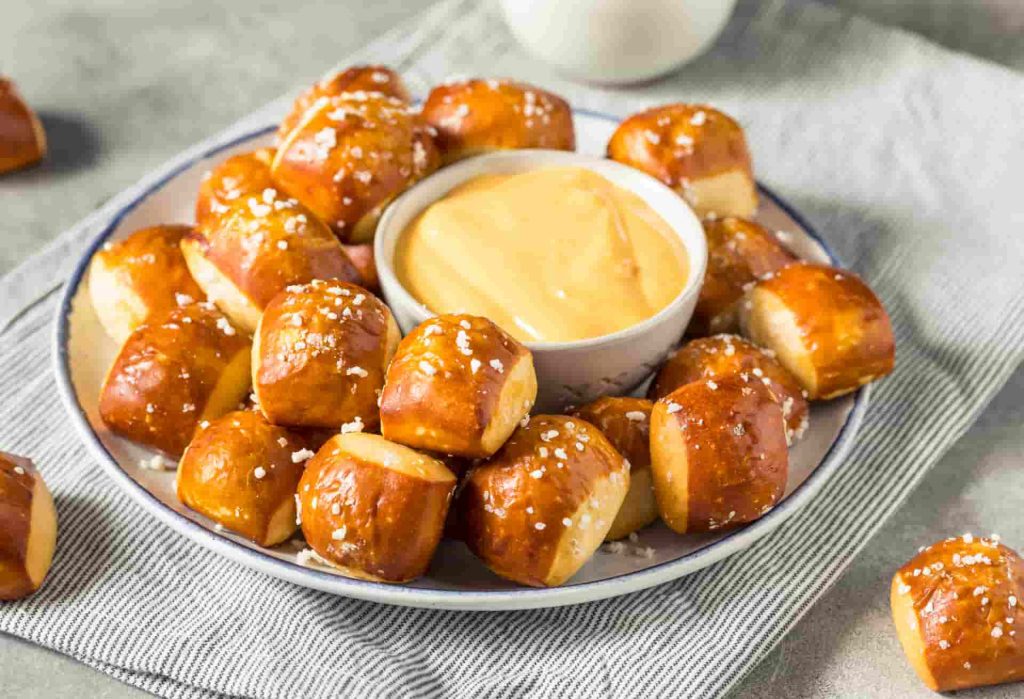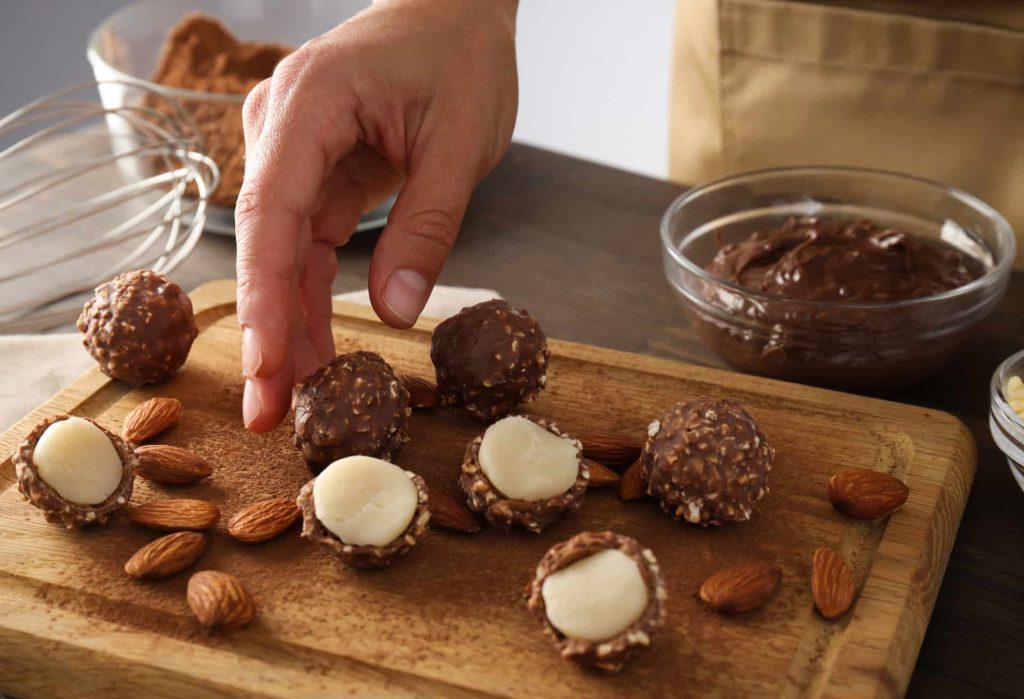
Did you know that German cuisine is much more than just meat and potatoes?
It’s a rich tapestry woven with history, regional diversity, and an unabashed love for hearty flavors.
From the bustling streets of Berlin, where the tantalizing aroma of Currywurst beckons, to the tranquil towns where Sauerkraut reigns supreme, German cuisine is a testament to its vibrant culture.
But what makes Currywurst so irresistible? How did Sauerkraut become a staple in German households? Join us as we embark on a gastronomic adventure ‘From Currywurst to Sauerkraut,’ unraveling the stories behind these iconic dishes and more.
Prepare your taste buds, and let’s dive fork-first into the delicious world of Germany’s cherished culinary delights!
Top 4 German Cuisines You Need to Get Your Hands On
Germany has an extravaganza of cuisines you need to look out for. We have listed out our favourites below:
#1 The Birth of Currywurst: A Berlin Specialty
In the rubble of post-war Berlin, a savory sensation was born: the Currywurst. This iconic German fast-food dish owes its creation to Herta Heuwer, a resourceful woman who in 1949 mixed together curry powder and ketchup to coat grilled pork sausage. This simple yet revolutionary concoction rapidly won the hearts of Berliners and has since become a symbol of the city’s resilience and innovation.
Currywurst is essentially a steamed, then fried sausage (typically pork), sliced into bite-sized pieces and slathered in a distinctive curry-ketchup sauce. It’s often served with a side of crispy fries or a roll, making for a satisfying quick meal. Variations abound, from the choice of sausage (with or without casing) to the sauce’s spice levels and the addition of toppings like onions or mayo.

Check this out: Nightlife in Germany: What Should Your Weekends in Germany Look Like?
Craving a taste?
- Konnopke’s Imbiss: A historic spot under the Eberswalder Straße U-Bahn station, serving Currywurst since 1960.
- Curry 36: A beloved institution in Kreuzberg, known for its traditional take on the classic dish.
- Curry at the Wall: Located near Checkpoint Charlie, it offers a historical setting to enjoy this iconic Berliner fare.
- Bier’s Kudamm 195: A popular choice among locals, offering a flavorful Currywurst sauce that’s been a hit since its opening.
#2 Sauerkraut: A Tangy Staple with a Rich History
Sauerkraut, with its tangy crunch and sour zing, is not just a side dish; it’s a journey through time. Its origins trace back to ancient China, over 2,000 years ago, where it was discovered that fermenting cabbage could preserve it for longer periods.
This technique eventually made its way to Europe, and by the 16th century, Sauerkraut had become a German cuisine staple. Beyond its longevity, Sauerkraut is packed with probiotics, vitamins, and minerals, making it a superfood long before the term was coined.
In Germany, Sauerkraut is more than a dish; it’s a palette of regional flavors. In the South, it’s often sweeter, sometimes kissed with apples. The North favors a more straightforward, tangier variant. This diversity of German cuisine extends to the methods of preparation and consumption, with each region infusing its unique cultural and culinary touch.
Sauerkraut Pairings to Look Out For
- Sauerkraut with Bratwurst: A classic combination, balancing the richness of the sausage with the acidity of the kraut.
- Kassler Rippchen: Smoked pork chops atop a bed of warm Sauerkraut.
- Sauerbraten: This marinated roast finds its perfect tangy companion in a side of Sauerkraut.
- Schweinshaxe: The crispy pork knuckle’s fattiness is cut through by the kraut’s sharpness, creating a harmonious bite.

You might be interested in this: Freelancing in Germany: What All Should You Know to Start Off
Destinations to Experience Sauerkraut
- Munich’s Viktualienmarkt: Sample artisanal Sauerkraut varieties from local vendors.
- Cologne’s Früh am Dom: Known for its traditional Cologne-style Sauerkraut.
- Altes Hackerhaus in Munich: Offers a historic ambiance to enjoy classic Bavarian dishes with Sauerkraut.
- Freiburg’s Hausbrauerei Feierling: Combine fresh Sauerkraut with locally brewed beer for a true German experience.
#3 The Bavarian Pride: Pretzels and Beer’s Role in German Cuisine
The iconic looped knot of a Pretzel is as much a symbol of Bavaria as the lederhosen and dirndl. With a history possibly dating back to the Early Middle Ages, the Pretzel is steeped in folklore and tradition.
In tandem with Pretzels, beer flows through Bavaria’s veins. German beer culture is renowned worldwide, and Bavaria is its heartland, thanks to the Reinheitsgebot, or Beer Purity Law, of 1516. This decree, the oldest food regulation still in use today, ensures the quality and tradition of German beer. In Bavaria, sipping a beer without a Pretzel in hand is nearly unthinkable.
Oktoberfest, Munich’s legendary festival, is a testament to this divine pairing. Millions gather not only to celebrate Bavarian culture but to indulge in the iconic duo of Pretzels and beer under the autumn sky. The festival’s tents are a paradise for enthusiasts, overflowing with freshly baked Pretzels and barrels of the finest local brews.
The Quintessential Bavarian Pretzel and Beer Experience
- Hofbräuhaus München: Perhaps the most famous beer hall in Munich, offering a lively atmosphere.
- Augustiner Bräustuben: Taste beer from Munich’s oldest independent brewery.
- Brezn: Known for their hand-twisted Pretzels, perfect with a cold beer.
- Chinesischer Turm Beer Garden: Enjoy a Pretzel and beer in the English Garden, one of the world’s largest urban parks.

We think you might enjoy this: Transportation in Berlin: 10 Tips For When You Are Lost in the City
#4 The Sweet Side of Germany: Black Forest Cake and Marzipan
German cuisine is not confined to savory delights; it’s also home to some of the world’s most beloved sweet treats. Among them, the Black Forest Cake, or Schwarzwälder Kirschtorte, stands tall with its indulgent layers.

Originating from the Black Forest region, this decadent dessert is a symphony of flavors: airy chocolate sponge cake, luscious whipped cream, and the distinctive kick of Kirsch, a cherry brandy. The cake is a testament to the region’s bountiful cherry harvests and its tradition of Kirsch production, uniting local ingredients in a globally cherished dessert.
Further north, the Hanseatic city of Lübeck takes pride in its Marzipan, a confection made from sugar and ground almonds. Lübeck’s Marzipan, recognized for its high almond content and fine quality, is a product of centuries-old craftsmanship. The city’s confectioners have honed their skills over generations, elevating Marzipan to an art form, beautifully sculpted and painted to resemble fruits, animals, and various figures.
Recommendations For Patisseries to Indulge in Desserts
- Café König in Baden-Baden: Renowned for its authentic Black Forest Cake.
- Café Niederegger in Lübeck: The epitome of Marzipan artistry, a must-visit for any Marzipan aficionado.
- Schwarzwaldstuben in Berlin: Offers a delightful slice of Black Forest Cake in the capital.
- Marzipanland in Hamburg: A haven for Marzipan lovers, featuring a wide array of Marzipan creations.

Also read: 7 Best German Language Schools in Berlin
Drawing the Curtains on this German Cuisine Adventure…
…we’re left with a rich tapestry of German cuisines, flavors and memories that define the country’s identity.
We’ve explored the bustling streets of Berlin with its iconic Currywurst, tasted the tangy depths of Sauerkraut, and reveled in the convivial tradition of Pretzels and beer in Bavarian beer gardens. Our sweet finale in the Black Forest and Lübeck was a testament to the artistry and heritage ingrained in Germany’s confectionery.
This journey has been more than a mere sampling of dishes; it’s been a passport to the heart of German culture, history, and communal spirit. Each meal, each tradition, beckons us to explore further, to gather around the table, and to savor the stories woven into every bite.
Guten Appetit!




